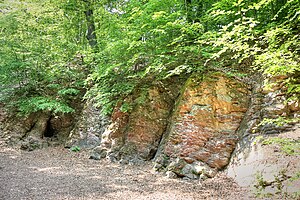Burning mountain
| Burning mountain | ||
|---|---|---|
|
Crevices in the rock with heat escaping through smoldering |
||
| height | 357 m above sea level NN | |
| location | Saarland ( Germany ) | |
| Mountains | Saar coal forest | |
| Coordinates | 49 ° 17 ′ 1 ″ N , 7 ° 3 ′ 21 ″ E | |
|
|
||
| Type | Back mountain | |
| particularities | ND Burning Mountain | |
The Burning Mountain ( 356.7 m above sea level ) is a wooded hill on the border of the Saarland cities of Saarbrücken and Sulzbach . It houses a smoldering coal seam that caught fire in the 17th century, is still smoldering today and is a natural monument .
Geographical location
The Burning Mountain is located between the Saarbrücken district of Dudweiler in the west and the Sulzbach district of Neuweiler in the east and belongs to the Saar coal forest . It is the south-western part of a ridge that extends in a north-easterly direction over the Sechseichenkopf (365.8 m above sea level ), Hoferkopf (395.0 m above sea level) near Friedrichsthal (Saar) and from there rather northwest to the Hammerich (396 , 3 m above sea level) near Heiligenwald . The north-eastern Saar tributary Sulzbach flows west past the wooded Brennenden Berg from the north-east of Sulzbach . A little east-north-east of its summit is a transmitter mast ( 353.5 m above sea level ; location ) on the outskirts of Neuweiler .
history
The natural monument Brennender Berg ( 327.6 m above sea level ; location ) is located around 500 m north-north-west of the hilltop in a kind of gorge that was created by the mining of alum slate . According to tradition, a coal seam near the day caught fire here in the 1660s. It was probably a matter of spontaneous combustion from pressure and decomposition as a result of unplanned coal extraction. The oral tradition claims that a shepherd was sparked by a tree Stock a fire that had entered through the roots into the seam. At first attempts were made to fight the fire with water, but this was unsuccessful.
The seam does not burn with an open flame , but glows . According to reports and drawings from the 18th century, the embers could be seen through cracks in the rock and there was heavy smoke development. Depending on the weather, vapors can still be observed today, and the escape of warm air can still be felt at least in a rock crevice.
tourism
The natural monument on the Burning Mountain is one of the attractions of the region. It is a popular destination for excursions and hiking days at school. Good starting points for hikes are the ASC Dudweiler parking lot in the street Am Gegenortschacht and the Brennender-Berg-Straße in Neuweiler; at the end of the road, near the turner, a slightly sloping, narrow forest path, which is marked with a vertical green diamond, leads to the natural monument about 800 meters away.
Even Johann Wolfgang von Goethe , who moved the start of the fire in the 1760s, visited in July 1770 the Burning Mountain, what a plaque recalls. He wrote poetry and truth about the visit four decades later in his memoirs :
“We heard of the wealthy Dutweiler coal mines, of iron and alum works, and even of a burning mountain, and prepared ourselves to look at these wonders nearby. [...] We stepped into a ravine and found ourselves in the region of the burning mountain. A strong smell of sulfur moved us; one side of the cave was almost glowing, covered with reddish, white-burned stone; a thick steam rose from the clumps and you could feel the heat of the ground through the strong soles. "
literature
- Christian Friedrich Habel: Contributions to the natural history and economy of the Nassau countries , Dessau 1784, pp. 10–38. Online at Google books
- Samuel Christoph Wagener: About the Palatinate on the Rhine and its neighborhood, especially with regard to the current war, natural beauties, culture and antiquities , Brandenburg 1795, pp. 35-45. Online at Bavarica
- Martin Schuto: New branches of industry - alum smelters , coke production, brewhouse. In: 1000 years of Dudweiler 977–1977 . Saarbrücker Zeitung-Verlag. Saarbrücken 1977. pp. 228-233.
- Karl Heinz Ruth: The alum extraction on the burning mountain. In: Historical contributions from the work of the Dudweiler history workshop. Volume 5. Saarbrücken 1988, pp. 1-17.
- Werner Zimmer: From the Devil's Bridge to the Burning Mountain, "Historical Contributions" Dudweiler Geschichtswerkstatt, Volume 9, pp. 40–55, Dudweiler 2006.
- Johann Wolfgang von Goethe: From my life - poetry and truth, 10th book
Web links
- Training center Burbach: Burning mountain
- Günter Fell: Burning Mountain
- Umfragencenter.de: Burning mountain
- Saartanisch.de: The Burning Mountain near Dudweiler
- Burning coal seams: fire under the earth sueddeutsche.de , January 17, 2008
Individual evidence
- ↑ a b c Map services of the Federal Agency for Nature Conservation ( information )
- ↑ a b Landesvermessungsamt des Saarlandes (Ed.): Topographische Karte 1: 25 000 6708 St. Johann . Self-published, Saarbrücken 1974.
- ^ Christian Friedrich Habel: Contributions to the natural history and economy of the Nassau countries , Dessau 1784, p. 16
- ^ Christian Friedrich Habel: Contributions to the natural history and economy of the Nassau countries , Dessau 1784, p. 17
- ↑ Johann Wolfgang von Goethe : Poetry and Truth. Second part. Tenth book . 1812. Internet site ( memento of September 8, 2005 in the Internet Archive )






